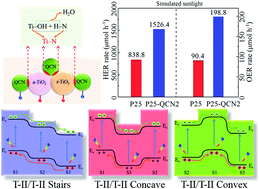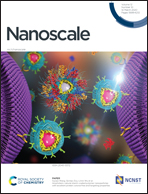Type-II/type-II band alignment to boost spatial charge separation: a case study of g-C3N4 quantum dots/a-TiO2/r-TiO2 for highly efficient photocatalytic hydrogen and oxygen evolution†
Abstract
Efficient spatial charge separation and transfer that are critical factors for solar energy conversion primarily depend on the energetic alignment of the band edges at interfaces in heterojunctions. Herein, we first report that constructing a 0D/0D type-II(T-II)/T-II heterojunction is an effective strategy to ingeniously achieve long-range charge separation by taking a ternary heterojunction of TiO2 and graphitic carbon nitride (g-C3N4) as a proof-of-concept. Incorporating g-C3N4 quantum dots (QCN), as the third component, into the commercial P25 composed of anatase (a-TiO2) and rutile (r-TiO2) can be realized via simply mixing the commercially available Degussa P25 and QCN solution followed by heat treatment. The strong coupling and matching band structures among a-TiO2, r-TiO2 and QCN result in the construction of novel T-II/T-II heterojunctions, which would promote the spatial separation and transfer of photogenerated electrons and holes. Moreover, QCN plays a key role in reinforcing light absorption. Particularly, the unique 0D/0D architecture possesses the advantages of abundant active sites for the photocatalytic reaction. As a result, the optimized QCN/a-TiO2/r-TiO2 heterojunctions exhibit enhanced photocatalytic H2 and O2 evolution, especially the hydrogen evolution rate (49.3 μmol h−1) is 11.7 times that of bare P25 under visible light irradiation, and sufficient catalytic stability as evidenced by the recycling experiments. The remarkably enhanced photocatalytic activity can be attributed to the synergistic effects of the energy level alignment at interfaces, the dimensionality and component of the heterojunctions. This work provides a stepping stone towards the design of novel heterojunctions for photocatalytic water splitting.



 Please wait while we load your content...
Please wait while we load your content...